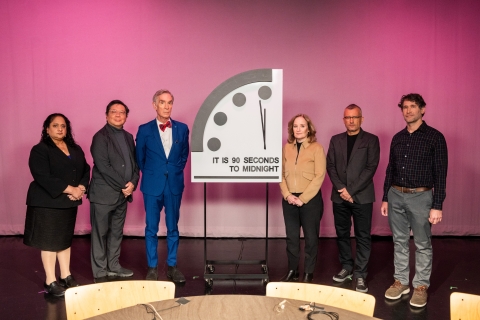
Symbolic clock indicates the world remains perilously close to catastrophe.
The following article was published in the March-April 2024 issue of NewsNotes.
The Science and Security Board of the Bulletin of the Atomic Scientists has decided to keep the Doomsday Clock set at 90 seconds to midnight for a second consecutive year. For 77 years, the Doomsday Clock has been set annually based on the state of world affairs, especially under the threat of nuclear annihilation, as a visual symbol of how close the world is to apocalyptic global catastrophe.
In a statement on Jan. 23 explaining the decision, the members of the board wrote that they “have been deeply worried about the deteriorating state of the world.” They set the Doomsday Clock at two minutes to midnight in 2019 and at 100 seconds to midnight in 2022. Last year, they moved the clock to 90 seconds to midnight—the closest to global catastrophe it has ever been—in large part because of Russian threats to use nuclear weapons in the war in Ukraine.
Board members said they chose to keep the clock set at 90 seconds to midnight because “humanity continues to face an unprecedented level of danger.” Rather than growing complacent with this position, they want the world to see it as a “stark warning and respond urgently, as if today were the most dangerous moment in modern history. Because it may well be.”
In recent decades, the board has considered new existential threats such as climate change, together with the nuclear threat, in deciding how to set the clock. The current report cites several threats that led to the decision to leave the clock set so close to Doomsday:
The nuclear risk remains dire, particularly as wars involving nuclear powers, Russia and Israel, threaten to escalate and expand to wider regional conflicts and tensions rise between nuclear-armed states while the international arms control regime continues to crumble.
Russia’s war in Ukraine continues unabated, while President Putin has suspended Russian participation in the New START arms control treaty, sent tactical nuclear weapons to Belarus, and Russia withdrew from the Comprehensive Nuclear Test Ban Treaty. Meanwhile, the United States has suspended certain elements of its own participation in New START in response, has never signed the test ban treaty.
“Nuclear spending... in the three largest nuclear powers—China, Russia, and the United States—threaten to trigger a three-way nuclear arms race as the world’s arms control architecture collapses,” the report states.
Meanwhile, Iran continues to develop near-weapons-grade plutonium, the Iran nuclear deal is no closer to being salvaged, North Korea continues to develop nuclear weapons, and nuclear weapons state Israel’s war on Gaza continues to spread, threating a wider and unpredictable regional conflict.
Climate change is also a risk as progress toward the Paris Agreement goals remains slower than is needed, and even a record-breaking $1.7 trillion global investment in renewable energy and new renewable energy commitments by countries representing half the world’s gross domestic product are offset by continuing trillion-dollar investment in fossil fuels. The year 2023 was the “hottest year on record and global greenhouse gas emissions continued to rise.”
Biological threats are increasingly alarming in the wake of the COVID 19 pandemic, as advances in biotechnology increase the risk of weaponized and accidentally-released disease – a threat made more volatile through advances in artificial intelligence (AI).
Disruptive technologies, too, are a growing factor in deciding the setting of the Doomsday Clock. In particular, multiple uses of AI advance nuclear and conventional-weapons and biological dangers, and undermine democratic systems through the proliferation of misinformation.
“AI has great potential to magnify disinformation and corrupt the information environment on which democracy depends. AI-enabled disinformation efforts could be a factor that prevents the world from dealing effectively with nuclear risks, pandemics, and climate change,” according to the report. “Military uses of AI are accelerating. Of particular concern are lethal autonomous weapons, which identify and destroy targets without human intervention. Decisions to put AI in control of important physical systems—in particular, nuclear weapons—could indeed pose a direct existential threat to humanity.”
Catholic Church leaders, too, have been sounding the alarm about many of these threats. Pope Francis has sharpened church teaching on the climate and integral ecology with Laudato Si’; advanced the Church’s position on nuclear weapons by condemning their possession, even for the purpose of deterrence; and he dedicated his 2024 World Day of Peace Message to the issue of AI.
Faith in action
On January 27, Pax Christi USA offered an online forum, “Building A World Without Nuclear Weapons: An Urgent Imperative,” featuring Santa Fe Archbishop John Wester, Pax Christi International’s Marie Dennis, and Dr. Ira Helfand of the International Campaign to Abolish Nuclear Weapons.
Watch the recording: https://mogc.info/PaxChristiNukes
Photo from the unveiling of the Doomsday Clock for 2024 from the Bulletin of Atomic Scientists.
